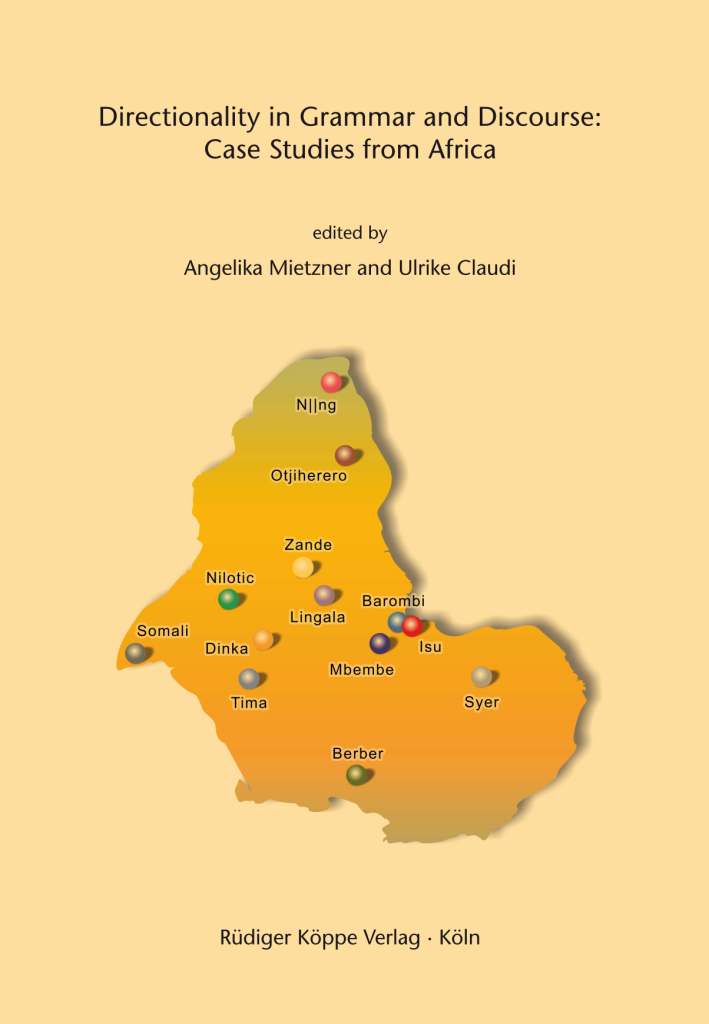
Directionality in Grammar and Discourse
Case Studies from Africa
Edited by: Angelika Mietzner, Ulrike Claudi. With contributions by: Suzan Alamin, Torben Andersen, Gratien G. Atindogbé, Ulrike Claudi, Gerrit J. Dimmendaal, Klaudia Dombrowsky-Hahn, Martina Ernszt, Axel Fleisch, Roland Kießling, Angelika Mietzner, Wilhelm J.G. Möhlig †, Nico Nassenstein, Helma Pasch, Doris Richter gen. Kemmermann, Gertrud Schneider-Blum.
Series: TIAS Topics in Interdisciplinary African Studies Volume 29
2012232 pp.
2 colour maps, 1 map, 19 figures, 2 graphs, 1 dendrogramme, numerous tables and charts
Text language(s): English
E-book
€ 69.80
Buy 'Directionality in Grammar and Discourse' as a downloadable PDF document directly from our online shop »
This volume on the expression of directionality in African languages is the output of a workshop Directionality in Grammar and Discourse: Evidence from African Languages that was held at the University of Cologne, Germany in June 10–11, 2010. This workshop on directionality was a continuation of a previous one on Encoding Motion: Case Studies from Africa, which was held in 2007. The results of the 2007 workshop have been published under the same title – edited by Angelika Mietzner and Yvonne Treis (see the link below).
The idea of planning such a workshop was motivated by the fact that a large number of African languages exhibit multiple ways of expressing the direction towards or away from a deictic center, either by fixed morphemes or by other grammatical elements. Former research had also revealed that directional morphology may develop semantics that go beyond the encoding of direction properly. So, the question was: How do African languages encode directionality, and in which way may particular forms receive semantics that have no obvious semantic relation to directionality?
The participants presented papers on Afroasiatic, Niger-Congo, Nilo-Saharan and Khoisan languages, i.e. on languages of all of the four African language phyla: the Afroasiatic phylum is represented by Berber (Fleisch) and Somali (Northern Cushitic; Claudi). Niger-Congo is represented by Tima (Eastern Sudanic; Alamin / Schneider-Blum / Dimmendaal), Zande (Ubangi; Pasch), Mbembe (Jukunoid; Richter gen. Kemmermann), Syer (Senufo; Dombrowsky-Hahn), as well as by Bantu languages (Atindogbé, Möhlig, Nassenstein). Nilo-Saharan languages are represented by languages of the Eastern Sudanic branch, Dinka (Western Nilotic; Andersen), Nilotic (Mietzner) and Nubian (Jakobi). One Khoisan language was investigated, namely Nǁng (Ernszt).
CONTENTS
Suzan Alamin / Gertrud Schneider-Blum / Gerrit J. Dimmendaal: Finding your way in Tima
Torben Andersen: Verbal directionality and argument alternation in Dinka
Gratien G. Atindogbé: On the typology of directional verbs in Bantu A (Barombi, Isubu, Mokpe, and Oroko)
Ulrike Claudi: Who moves, and why? Somali deictic particles
Klaudia Dombrowsky-Hahn: Grammaticalization of the deictic verbs ‘come’ and ‘go’ in Syer
Martina Ernszt: On the different uses of the deictic directional verbs ‘go’ and ‘come’ in N||ng
Axel Fleisch: Directionality in Berber – Orientational clitics in Tashelhiyt and related varieties
Roland Kiessling: Extensive is up, intensive is down – the vertical directional background of the adverbials k/ vs. ts/ in Isu
Angelika Mietzner: Spatial orientation in Nilotic languages and the forces of innovation
Wilhelm J.G. Möhlig: Directionality as a basic principle in Otjiherero verb constructions
Nico Nassenstein: Directionality in Lingala
Helma Pasch: Two multifunctional locative and directional prepositions in Zande
Doris Richter gen. Kemmermann: Directional verbs in Mbembe
Under these links you will find publications by the contributors and further studies of deixis in African languages:
Accompanying material:
- Deictics, Copula, and Focus in the Ethiopian Convergence Area
(ISBN 978-3-89645-293-1 ) - Encoding Emotions in Swahili
(ISBN 978-3-89645-715-8 ) - Encoding Motion – Case Studies from Africa
(ISBN 978-3-89645-505-5 ) - Motion in Datooga
(ISBN 978-3-89645-668-7 ) - Räumliche Orientierung in nilotischen Sprachen
(ISBN 978-3-89645-661-8 )
Cross-reference:
- A Grammatical Sketch of Herero (Otjiherero)
(ISBN 978-3-89645-044-9 ) - A Tima-English Dictionary
(ISBN 978-3-89645-901-5 ) - Bankon (A40)
(ISBN 978-3-89645-030-2 ) - Cherang’any
(ISBN 978-3-89645-666-3 ) - Domains and Regions in Bantu Tense and Aspect
(ISBN 978-3-89645-772-1 ) - Khoisan Languages and Linguistics – 3rd Symposium 2008
(ISBN 978-3-89645-873-5 ) - Lucazi Grammar
(ISBN 978-3-89645-038-8 ) - Reference Grammar of Herero (Otjiherero)
(ISBN 978-3-89645-602-1 ) - Verbal Serialisation in Isu (West Ring)
(ISBN 978-3-89645-555-0 )
Reviews
As evidenced by all the sample material discussed in the book, African languages use various grammatical means to provide precise location or motion towards or away from a deictic center. However, the authors go far beyond in their investigations and demonstrate how metaphor and pragmatic strengthening transfer the expressions primarily associated with spatial concepts onto many other cognitive domains, including: vision, orientation, social interactions, and highly abstract grammaticalized domains. Hence, directionality appears as a broad concept covering various functions of language specific grams (lexical expressions, particles, morphemes) used in a number of different pragmatic contexts. In addition, many authors provide a diachronic aspect of analysis and trace directional grams to their etymological sources, which include, among others, verbs of motion and body part terms. [...]
To conclude, the volume provides a lot of valuable linguistic material and analyses and can be recommended to all interested in African languages and typological studies.
Iwona Kraska-Szlenk in Studies of the Department of African Languages and Cultures, 47/2013, 125-129
| « back | Print version | [top] |
 Books
Books Audio
Audio Biographies
Biographies Series
Series Festschrifts
Festschrifts Journals
Journals